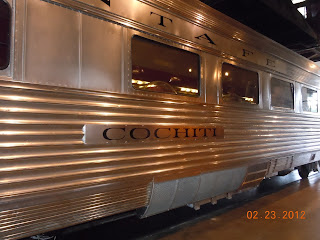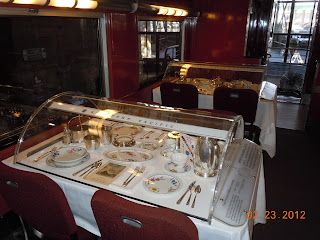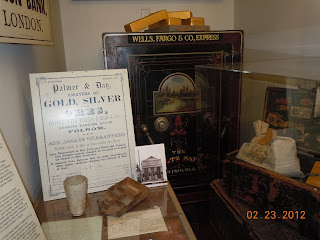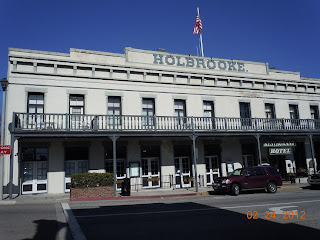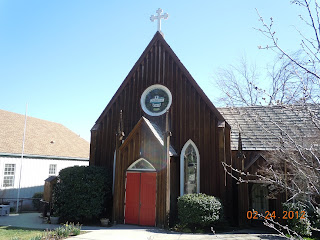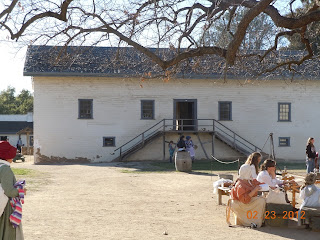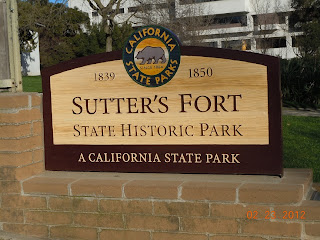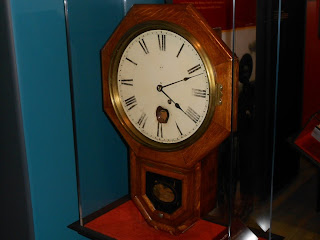One is that the town is tucked into the scenic Sierra Nevada Mountains not far north of both Auburn and Grass Valley, two other great gold mining tour stops. Another is the rich history you can experience. Nevada City CA history includes both the large mining operations which was the first reason for it's existence and also the colorful characters who inhabited the town during it's heydays.
Today's Nevada City
 |
| Nevada City California |
Just strolling through town is one of the fun things to do that are free. The entire downtown area of Nevada City California is like one large museum. Tourists enjoy quality restaurants, comfortable and quite unique lodgings and a variety of fine shops, boutiques, galleries and museums. While you can tour Nevada City in one day, you'll have no trouble finding enough great historic sites to make your stay a multi-day excursion.
Nevada City in many respects was like other gold rush towns. It had it's customary three dozen bars, it's gambling houses and it's theaters. Like most of the other gold towns, Nevada City merely started out as a camp and as it's mining fortunes grew, so did the camp. Eventually, the camp became a town. The city today has a population of about 3,000. In 1850, just one year after it's settlement, there were 10,000 people living there. In fact, in the general election of 1856 there were 2,082 ballots cast in Nevada City. This was exceeded in the state of California only by Sacramento and San Francisco. The town was incorporated in 1856 and the word "City" was added to it's name. This helped differentiate it from the nearby Territory of Nevada.
 |
| Nevada Theatre |
One interesting historic site while touring Nevada City, and there are many, is the old Nevada Theatre.
The Nevada Theatre, established in 1865, is California’s oldest original-use theater. It is still in use today. It's history of performances tell a lot about just how old this theater building is. Over it's nearly 150 years, the Nevada Theatre hosted performances by Mark Twain to Motley Crue and the Second City comedy troupe.
In the old days, in addition to Mark Twain who spent a great deal of time in the gold country, noted performers included Edwin Booth, older brother of John Wilkes booth. It was in Nevada City that Edwin Booth first acted the role of Iago, the villain of Shakespeare’s tragedy “Othello.” For years to come, Booth was recognized as the foremost tragedian of the American stage. Another very notable actress of the 1800's who performed at the Nevada Theatre was Lotta Crabtree from nearby Grass Valley. Lotta went on to become the first entertainer millionaire. Yet, another performer who was seen on the stage in Nevada City was Jack London who resided in the north San Francisco Bay area.
Firehouse Museum
 |
| Nevada City Firehouse No. 1 |
This firehouse was built in 1861 and it housed the Nevada Hose Co. No. 1 from 1861 all the way to 1938. Everything from horse drawn wagons to modern fire engines rolled out of this fire house. The fire house is located at 215 Main Street. The Nevada County Historical Society established this building as its first museum, the Firehouse No. 1, in 1947.
The National Hotel
The National Hotel is listed on the National Register of Historic Places. Out of all the old hotels in Nevada City, the National Hotel is the most historic.
Prior to being named the National Hotel, the structure opened in August of 1856 under the name of "Bicknell Block". The Bicknell Block housed just about everything of major importance during the early days. The stagecoach stop, post office and telegraph office. This hotel is considered one of the oldest hotels west of the Rocky Mountains that has been in continuous operation. When you step inside it's like a trip back to the Victorian era. The hotel is the site of California Historic Landmark No. 899 and is the most noted of the old hotels in the California gold country.
When you tour Nevada City make certain to walk inside the National Hotel. You'll see Victorian era furnishings and decor throughout. Wall coverings and carpeting as well as numerous artifacts give the National Hotel the look of a Victorian museum.
As you can imagine, the National Hotel is still very popular as a place to stay with visitors to Nevada City. The National Hotel offers comfortable lodging in an old-fashioned setting. The hotel includes forty-two rooms and a Victorian dining room. The location is right in the heart of downtown Nevada City.
Being such a historic city as it is, Nevada City California is filled with historic buildings. Another pictured here is the Kidd-Knox Building, shown below. The first structure was built in 1850. It was a two story frame building. It originally housed a theater and a reading room on the second floor. That structure was destroyed in the great fire of 1856 and was replaced with a two story brick building.
Fires ravaged several gold mining era towns. The first structures built throughout the California gold region were built from wood. Effective fire fighting equipment was absent during the towns very first years and when fire destroyed much of Nevada City and other nearby towns, brick became the building material of choice. Today, you see many of these original brick buildings still standing.
Two additional related Western Trips articles are about the Grass Valley California gold mining town and the story of Sutters Fort in Sacramento.
Visiting Nevada City California
Many people today travel to Nevada City for weekend getaways.
Unique bed and breakfast inns, wine tasting rooms, art galleries and world class restaurants are among the attractions. Because of Nevada City's elevation in the Sierra Nevada, fall colors abound with the cooler temperatures and this is another reason why a fall weekend trip to gold country is a lot of fun.
One of the things that visitors to the California gold country soon realize is all of the fun things to do that are free. Nevada City California is one of a string of old California gold mining towns that bring history to life. Nevada City CA is located about 65 miles northeast of Sacramento. The drive is about one hour and twenty minutes.
California Route 49 and Route 20 offer a scenic detour to Interstate 80 while driving between Reno Nevada and Sacramento California. The driving route can be accessed from the west at Auburn California which is directly on Interstate 80.
Accessing this route from the east, look for either the Yuba Pass or Emigrant Gap exits high up in the Sierras. Driving distance from Emigrant Gap to Nevada City is about 32 miles and takes about forty minutes to drive. If time allows, this detour is great fun and takes you through very scenic Sierra Nevada country as well as through the old gold mining towns of Nevada City and Grass Valley California. It's a scenic alternate route well worth the extra time.
(Article and photos copyright Western Trips)
Prior to being named the National Hotel, the structure opened in August of 1856 under the name of "Bicknell Block". The Bicknell Block housed just about everything of major importance during the early days. The stagecoach stop, post office and telegraph office. This hotel is considered one of the oldest hotels west of the Rocky Mountains that has been in continuous operation. When you step inside it's like a trip back to the Victorian era. The hotel is the site of California Historic Landmark No. 899 and is the most noted of the old hotels in the California gold country.
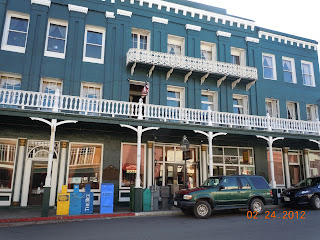 |
| National Hotel, Nevada City |
As you can imagine, the National Hotel is still very popular as a place to stay with visitors to Nevada City. The National Hotel offers comfortable lodging in an old-fashioned setting. The hotel includes forty-two rooms and a Victorian dining room. The location is right in the heart of downtown Nevada City.
Being such a historic city as it is, Nevada City California is filled with historic buildings. Another pictured here is the Kidd-Knox Building, shown below. The first structure was built in 1850. It was a two story frame building. It originally housed a theater and a reading room on the second floor. That structure was destroyed in the great fire of 1856 and was replaced with a two story brick building.
Fires ravaged several gold mining era towns. The first structures built throughout the California gold region were built from wood. Effective fire fighting equipment was absent during the towns very first years and when fire destroyed much of Nevada City and other nearby towns, brick became the building material of choice. Today, you see many of these original brick buildings still standing.
Two additional related Western Trips articles are about the Grass Valley California gold mining town and the story of Sutters Fort in Sacramento.
Visiting Nevada City California
 |
| Kidd-Knox Building |
Unique bed and breakfast inns, wine tasting rooms, art galleries and world class restaurants are among the attractions. Because of Nevada City's elevation in the Sierra Nevada, fall colors abound with the cooler temperatures and this is another reason why a fall weekend trip to gold country is a lot of fun.
One of the things that visitors to the California gold country soon realize is all of the fun things to do that are free. Nevada City California is one of a string of old California gold mining towns that bring history to life. Nevada City CA is located about 65 miles northeast of Sacramento. The drive is about one hour and twenty minutes.
California Route 49 and Route 20 offer a scenic detour to Interstate 80 while driving between Reno Nevada and Sacramento California. The driving route can be accessed from the west at Auburn California which is directly on Interstate 80.
Accessing this route from the east, look for either the Yuba Pass or Emigrant Gap exits high up in the Sierras. Driving distance from Emigrant Gap to Nevada City is about 32 miles and takes about forty minutes to drive. If time allows, this detour is great fun and takes you through very scenic Sierra Nevada country as well as through the old gold mining towns of Nevada City and Grass Valley California. It's a scenic alternate route well worth the extra time.
(Article and photos copyright Western Trips)


